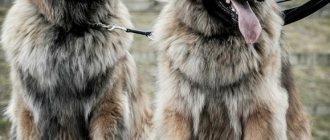It's not often you see a blue Doberman, even just on the street.
And meeting such a dog at an exhibition is completely unthinkable.
After all, despite the fact that the blue and tan color of these majestic and slender animals looks very impressive, it has always been quite rare.
And currently only American kennels are engaged in breeding such dogs.
Why is the blue Doberman considered such a rarity and what features make it unique?
Origin story and what it looks like in the photo
When the founder of the breed, Karl Friedrich Lewis Doberman, set out to create the perfect police dog that could also be a bodyguard dog, he used many other breeds in breeding animals, including Great Danes and, presumably, Weimaraners.
For these dogs, blue color is typical and, as researchers believe, it was thanks to the blood of Great Danes or Weimar pointers that the first steel-gray Dobermanns with rusty-red tan marks appeared.
In 1901, the blue color of the Doberman Pinschers was recognized as standard along with black and brown.
However, after genetic research carried out at the end of the 20th century, it was found that the gene for blue color in Dobermans is associated with some hereditary diseases.
The risk of possible health problems was the reason that the blue color was excluded from the FCI standard in 1994.
Doberman colors
Of course, the most common and most frequently encountered are the black Dobermans. Also, you can often see dogs of this breed in brown on the street. Brown Doberman , like black, is a classic in its own way. This is exactly how we are used to seeing animals of this color. And in fact, this dog breed was originally bred in these two colors. Therefore, previously only animals with these colors took part in exhibitions and competitions.
Of course, there are deviations from the norm and perfectly black or brown animals, without any inclusions or tan, are extremely difficult to find, if not impossible. The world standard of the Association of Cynologists allows:
- Black Doberman with tan markings. But an arbitrary mark will play a bad joke. Boundaries must be clearly defined. Inclusions are allowed only on the muzzle, withers, chest and paws. Other marks on the animal's body are not allowed, of course, if we are talking about a show dog.
- Doberman black and brown . Familiar, classic color, in which red markings are allowed. The placement of the red tan is similar to that of the black Doberman.
It is worth noting that in no case should you confuse brown and chocolate Dobermans. The second belongs to one of the types of mestizo, so it is unlikely to be suitable for breeding or participation in all kinds of exhibitions and competitions.
Red Doberman
This type of color is considered correct according to the breed standard, and such dogs are excellent for breeding and participation in competitions and exhibitions. Of course, the name red is too loud. No, these are not scarlet animals with bright, eye-catching colors. This is a rather discreet shade, it would be more correct to call it brown, because this color is difficult to describe in words.
It is worth noting that the red color can have a huge variety of shades, ranging from restrained light red-brown to dark, almost black with a reddish tint. When choosing a red puppy, keep in mind that there are no specific requirements for the shade. It is best to choose a medium red-brown pet.
White Doberman
Yes Yes. It exists, imagine! The Albino Doberman is a unique dog, both in appearance and in character. The uniqueness lies not only in the color of the coat, but also in the fact that this Doberman has blue eyes . The spectacle is both exciting and a little scary. The dog seems to come from some Hollywood movie full of special effects and computer graphics.
Such deviations from the standard were previously considered a curiosity, and dogs cost much more than their classic-colored counterparts. But times have changed, and now more and more people are inclined to believe that a light Doberman is an anomaly that significantly spoils the appearance of the pet. Moreover, it has been scientifically proven that the absence of colored coat pigment is a serious genetic malfunction in the animal’s body, which affects the pet’s entire life. White dogs are very sensitive to bright light and close and squint their eyes. Therefore, they often bump into various objects at home and on the street, and look slightly clumsy. They often get sick, most snow-white pets lose their hearing in old age, and problems with fur and vision may arise. In addition, genetic problems affected the character of the animal. Photophobia has led to the fact that albinos are more cowardly and less courageous than animals bred in the classic color. They are constrained in their movements, prone to unexpected actions, because fear due to lack of visibility can cause a storm of not the most favorable emotions in the dog. White Dobermans are considered to be more unpredictable and unbalanced than their counterparts.
Blue Doberman
Another extremely rare type of dog. In our country, such animals are quite difficult to find, because this Doberman coloring is considered a genetic failure, and experienced breeders do not advertise the appearance of such puppies. It is believed that the blue color of the animal's coat is caused by a black recessive gene (diluting). In turn, the Isabella Doberman is produced due to the red gene. In addition, there are scorch marks on the dog's body. Most often it is red in color, so sometimes due to the large number of markings, you might think that this is a red Doberman . Both the first color and the second are not very popular, since such dogs are considered weaker in health and mentally unstable.
It is worth noting that, unlike albinos, Dobermans of Isabella and blue colors are recognized in the world; dogs are allowed to participate in exhibitions in some countries. But, as practice shows, such animals rarely take prizes.
Doberman spotted
Do you think there are no spotted Dobermans? But that's not true. It is not uncommon to see a Doberman dog with a white spot, whose spots are located all over the body. Of course, spotting is not good, but it is a very affordable alternative for those who want to buy a good breeding dog, but do not have enough money.
Of course, to tell the truth, the breed standard excludes any spotted spots. Therefore, such a black and white Doberman can become an excellent pet and nothing more. After all, breeding will also be prohibited.
Marriage or breed?
Currently, the blue and tan color is considered a breeding defect..
Expert opinion
Kozhevin Semyon Kirillovich
Expert dog handler.
“The blue color of Dobermans looks unusual and impressive. But the weakening of the black pigment to a grayish-blue led to skin diseases becoming common in the breed. Therefore, the blue and tan color was eventually dropped from the official standard. If now there are advertisements for the sale of such puppies, then you need to understand that they were obtained from animals that do not have permission for breeding and that no one can guarantee how healthy they will be.”
Blue Doberman
Experts note the possible common origin of blue and Isabella Dobermans in the German pointing Weimaraner. Apart from their rare color, the dogs can be said to be definitely similar to each other. Isabella - a combination of two recessive genes, as well as blue and tan, is excluded from the European breed standards recognized by the FCI due to the prevailing opinion about the sickness of these dogs and their low working and usable qualities.
When choosing a Dobermann puppy of a rare color (especially if its breeder offers a higher price for such an exclusive one), you should remember possible problems and be very critical of the puppy you are purchasing. In this case, it is especially recommended to draw up a contract, since various hereditary diseases are more common among Dobermans of non-standard colors.
Another feature that is sometimes found in Dobermans of various colors is white spots. Their presence is genetically associated with the Irish spotting gene and such puppies cannot take part in breeding. Such a breeding match is usually very workable and will be an excellent choice for those who dream of a pedigree dog from a kennel, but cannot pay dearly for it. A mark that is too large or, conversely, too dark or light in a small area is also considered a serious drawback.
Because the breed comes in a wide range of colors, choosing the right puppy can be difficult, especially if there are puppies of different colors in the litter. At the age of one and a half months, one can speak quite confidently about the quality of the color, which allows the future owner to make the right and informed choice of their four-legged friend.
Advantages and disadvantages
pros:
- Unusual and rare color.
- The Blue Doberman is a loyal and devoted friend who treats all family members equally well.
- These dogs make reliable guards and bodyguards.
- Quite loyal to children.
- Hardy and strong.
- Smart and well trained dog.
- Characterized by courage and moderate malice.
- In normal circumstances he is calm and unperturbed.
Minuses:
- Can be aggressive towards strangers.
- It is highly territorial.
- From the first day the puppy appears in the house, the owner must become an indisputable authority for him.
- May chew or tear things in the house out of boredom.
- Not suitable for year-round outdoor use.
- He remembers grievances for a long time.
- Possible health problems.
The Blue Doberman is very sensitive and excitable, he needs affectionate, but at the same time, strict treatment.
Origin story
At the end of the 19th century in Germany, Karl F. Dobermann bred a breed of large guard dogs, which were named Dobermans in honor of the creator. In 1894, after the death of the breeder, the word "pinscher" was added to the name "Doberman". In 1949, during the editing of the standard, it was removed, returning the original name to the breed. Karl Friedrich Dobermann did not keep selection records, so no one knows about the true origin of the dogs. It is presumably believed that breeds such as pinschers, Great Danes and Rottweilers could have participated in the creation of the population.
Initially, individuals of this breed were stockier, without much grace, with an aggressive character. Later, breeder Otto Geller, when selecting Dobermans, removed puppies with a ferocious disposition from the litter, thereby softening the character of the breed. Today these are obedient, easy-going dogs that are easy to train, but have not lost their protective and detective qualities. The first show of Dobermann representatives took place in 1897 in Germany. Literally from that day on, the breed gained popularity, which has not been lost to this day. The FCI recognized the population in 1960.
Dimensions, weight and other distinctive features
The table below shows standard Doberman sizes:
| Options | Description |
| Height | Males - from 68 to 72 cm, females - from 63 to 68 cm. |
| Weight | Males - from 40 to 45 kg, females - from 32 to 35 kg. |
| Body Format | Square (for girls, slightly stretched is allowed). |
| Body type | Strong dry. |
| Musculature | Well developed. |
| Head | When viewed from above, it is wedge-shaped. The forehead is somewhat flat, the stop is quite pronounced, but small. |
| Muzzle | Elongated, length equal to ½ the length of the head. Moderately wide and deep; in males, as a rule, it is a little more massive than in females. |
| Teeth | White, strong, in full set, consisting of 42 teeth. |
| Bite | Scissor-shaped. |
| Ears | Natural length or docked. |
| Eyes | Not too large, but not small either, oval in shape. Their color is brown of varying lightness and intensity. |
| Neck | Set quite high, moderately muscular and dry. |
| Withers | Well expressed, as a rule, in males it is more developed. |
| Back | Straight, fairly muscular and moderately wide. When displayed, it forms a diagonal line directed downwards towards the croup. |
| Breast | Sufficient depth and width, oval in shape. |
| Stomach | Tight, forming a well-defined bend along the bottom line. |
| Forelegs | Straight and parallel, should not look too thin or too massive. |
| Hind limbs | Well muscled, with wide hips and good angulation of the hocks. |
| Tail | Shortly docked or left at natural length. |
| Wool | Quite tough, smooth, shiny and short. |
| Color | Bluish-steel of varying intensity. It can be either very light or dark, almost the color of wet asphalt. |
A blue Doberman must have a reddish-red tan.
What diseases are they susceptible to?
Like other Dobermans, blue and tan dogs may be predisposed to the following diseases:
- Cardiomyopathy.
- Dysplasia.
- Hypothyroidism.
- Allergies, including food allergies.
- Dermatitis.
- Gastric volvulus.
- Weakened immunity compared to black and brown color varieties of the breed.
NOTE!
Blue Dobermans are susceptible to skin diseases, especially often they have color mutational alopecia, which is expressed in the gradual baldness of certain areas of the body.
This disease appears between the ages of six months and three years, so it is simply impossible to predict whether a puppy will have it or not..
Due to the fact that this type of baldness associated with a weakened gene is especially common in dogs of this breed and color, it even received the unofficial name “Blue Doberman Syndrome.”
Choice
When choosing a puppy, you should pay attention to its appearance. It should be well-groomed, with clean mucous membranes, without swelling and foreign odors. A bloated stomach may indicate the presence of worms or a digestive problem. A healthy puppy is active and cheerful, he will run up to sniff the person who approaches him.
The patient will hide behind his mother or sit motionless. He may whine when picked up. Before making a choice, you should observe the puppies.
Overly aggressive or, conversely, timid puppies are not typical for this breed. Such behavioral reactions are considered a defect.
If coat color is important, you should check the color of the parents in the documents. Kids in black tones are usually recognized immediately. A black puppy without tan has only 2 shades: shiny and reddish. If others are present, it is better not to choose such a baby. When buying a Doberman, take into account the tasks that will be assigned to it and the price possibilities.
- Dogs costing $100-$270 may have slight deviations from the standard. Such animals do not participate in exhibitions. But this does not affect their character and mental abilities. Depending on their upbringing, they can become guards, guides, nannies, or simply kind and devoted friends.
- Puppies priced at $270-$400 are show eligible and suitable for breeding.
- Dogs costing over $400 have an ideal pedigree
Does color change with age?
The blue and tan color of Dobermans never changes too much and does not change colors.
It may become a little darker or a little lighter with age, and a more pronounced bluish or silvery sheen may appear..
Sometimes the intensity or shade of the tan may also change.
Doberman - the character of the breed
Louis Doberman - founder of the breed
History of the breed. So that you can better understand whether a Doberman is kind or evil, let us tell you a little history. Karl Friedrich Louis Dobermann became the creator of this popular breed. Doberman worked as a tax collector and in his spare time ran a shelter for stray dogs. While collecting taxes, Doberman needed protection and at that time he could not find a suitable dog for protection. And then he decided to breed the necessary breed himself. At one of the exhibitions, he bought a pair of Old German Pinschers, from which the Bismarck bitch was subsequently born, which was used for breeding. This is one of the few facts that are known for certain. Accurate information about all the breeds that took part in the appearance of the Doberman has not been preserved. And from different sources, data can vary dramatically. Karl Doberman created a dog that was fearless, resilient, fast, strong and did not require special care. An ideal dog for police service, because she also has an excellent sense of smell. Her speed and size did the trick. The fame of the vicious Thuringian Pinschers spread quickly.
Police Doberman Pinscher Club. One of the first Dobermans in service in Russia
Doberman Pinschers became popular as bodyguards and security guards. Otto Geller continued the work of the “father of the breed”. He was engaged in softening the character of the Doberman and was very successful in this. Which had a positive impact on their further spread throughout Europe and then throughout the world. It is thanks to him that we now know Dobermans as they are. good, kind and obedient dogs. By the way, Dobermans were brought to Russia in 1902 and of course they immediately became popular search dogs.
Doberman Day
It was on this day in 1958 that the International Canine Association decided to officially assign this name to the breed, instead of the previous one - “Doberman Pinscher”. And today, Dobermans are the only dog breed that bears the name given by the surname of the “godfather” of all Dobermans - Ludwik Dobermann.
Basic rules of care
The Blue Doberman requires minimal grooming. He needs to be brushed once a week and his ears and eyes cleaned as needed. You should not bathe your dog often, and given the tendency of blue Dobermans to allergies, it is better to do without washing at all.
The nails of a pet of this breed will not have to be cut very often, since if the dog walks on the asphalt quite a lot, they will grind down perfectly on their own..
If the blue Doberman needs to shorten its claws, then this should be done with a nail clipper purchased in advance from a veterinary pharmacy.
It is necessary to vaccinate your pet on time, as well as treat it against external and internal parasites..
You also need to regularly examine the dog’s coat and skin in order to notice the first signs of possible allergies or alopecia in time.
If any are noticed, then it is necessary to show the pet to a veterinarian as soon as possible.
Price range
Since the blue color is considered a breeding choice, these puppies are usually less expensive than the standard black and brown and tan.
The price range for these dogs is quite large: from 5-8 to 25-30 thousand rubles.
At the same time, the cost of a puppy depends not only on its quality, but on the ambitions of the breeder.
Doberman - meaning
The Doberman Pinscher dog, or simply Doberman, appeared in Germany around 1890. The dog received this name for the breed thanks to the surname of the person who selected it - Karl Friedrich Louis Dobermann. He himself called these dogs Thuringian Pinschers. After his death, this breed was called the Doberman Pinscher, and then simply Doberman.
Doberman Pinscher = Doberman
Photos of Dobermans
Doberman Pinscher photo
doberman dog photo
Doberman stands
what does a doberman look like
Doberman breed photo
photo of black Dobermans
white doberman photo
Doberman beautiful photos
adult Doberman
How to choose?
It should be remembered that it will not be possible to find a blue Doberman with documents of origin in Russia. This means that the future owner of such a pet will have to either buy a puppy without registration, or go to a foreign kennel to get the dog.
IMPORTANT!
Buying a puppy without documents is always fraught with the risk that the baby may have health problems or an unstable psyche.
If the decision to adopt a dog of this particular color is finally made, then you need to try to find a baby from dogs that have medical certificates.
When choosing a future pet, you need to give preference to a baby who does not show signs of cowardice or, conversely, aggression.
Lifespan
There is an opinion that Doberman dogs have a relatively short life expectancy. But is the Pinscher mortality rate really that high? There is no specific answer to this question.
The life expectancy of a pet directly depends on the following conditions:
- Proper care and maintenance. A Doberman dog should be kept in a warm apartment. A German dog must lead an active lifestyle. Constant walks in the fresh air are simply necessary.
- Healthy food. The quality of food directly depends on how long Dobermans live. You need high-quality food with the addition of the necessary vitamins.
- Genetics. Inherited diseases can shorten life expectancy. Information on how long white Dobermans live on average will remain a mystery. These dogs suffer from deafness, blindness, and photophobia. The duration of existence will depend on what living conditions the owner creates for them.
With decent care, a balanced diet and the absence of diseases, the life expectancy of dogs of this breed is from 12 to 15 years.
Take care of your four-legged friend and be happy!











